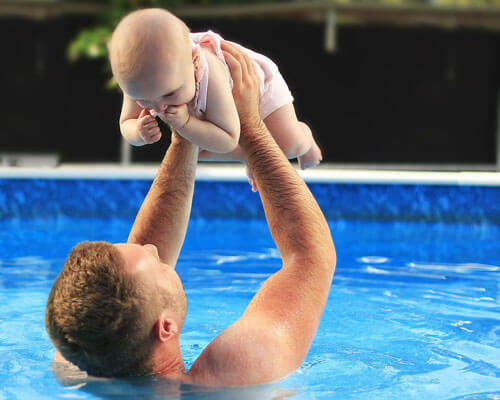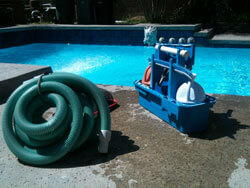
Upgrading Your Existing Pool Fence: DIY Options for 2025
Find the best pool fence options for upgrading your DIY removable mesh pool fence. These are our top suggestions to get the pool fence idea juices flowing.

Having a pool in your backyard means endless hours of fun with your family. Your first priority should be to keep your pool safe. Once you’ve secured your pool area with proper safety equipment, it’s time to talk about pool water. Before you jump in and enjoy the summer, there are a few essential tips to make sure your pool water is safe, clean, and ready for use.
One of the keys to avoiding contaminants like algae and bacteria is to regularly test your water’s chemical balance. If you use your pool frequently during the summer, test the water at least twice per week.
A chemical balance that’s too high or too low could both cause skin irritation or sickness, so the proper balance of chemicals in your pool for safe water can’t be overstated.

There are some germs, like cryptosporidium, that are chlorine-resistant. This hardy germ causes diarrhea and requires a special hyper-chlorination procedure to kill. Practice the healthy habits outlined later in the post to help avoid contamination.
Another key way to help prevent your family from getting sick from pool water and keep it safe is through the care and maintenance of your pump and filtration system. Using these systems for too long between backwashing the filter or changing the filter cartridge will reduce their effectiveness. That can invite the water to become home to bugs, mold, and other unpleasant organisms. Keeping the water flowing will help reduce these contaminants.
As you’re running the pump, also check the water levels. If the water is too low, it might not reach the pool skimmer and filter properly, potentially burning out your pump. If it’s too high, the skimmer door won’t work correctly and it will let in leaves and debris.

Especially important for safe pool water is to maintain a routine cleaning schedule. While the chemicals and filtration system will do a lot of the work for you, you’ll still need to regularly skim larger debris like leaves out of the pool.
Utilizing an automatic pool vacuum will save you time and add convenience. Though if you don’t have an automatic, you should still vacuum the bottom of your pool at least once per week by hand.
The filters in your system need consistent attention as well. Depending on the type of filter, whether you use sand, cartridge, or diatomaceous, you should remove it for deep cleaning at least once per season. Do this more often if you notice your water gains an unpleasant odor or seems dirtier than usual.
Also, don’t forget about your skimmer baskets and other parts of the pump system. Empty skimmer baskets at least once per week, and especially after a storm or heavy pool usage, to ensure your pool water remains safe.
Lastly, once a week you should shock your pool by adding three pounds of calcium hypochlorite shock to the water. This helps prevent the chlorine from becoming inactive by combining with other chemicals like ammonia and nitrogen.
If you’ve done all you can with chemical balance, filtration, and regular cleaning to keep your pool water safe and sparkling, it’s time to make sure your family practices healthy pool habits.
The CDC has a set of four steps to make sure your family doesn’t get sick from pool water:
For advice on everything from keeping your pool water safe and clean to securing your pool area with a fence, net, or cover, trust All-Safe Pool Fence & Covers. We were founded to protect the lives of children, and it continues to guide every decision we make.
Contact us for a free estimate of your pool area and your local dealer will provide recommendations for the best safety equipment for your family.

Find the best pool fence options for upgrading your DIY removable mesh pool fence. These are our top suggestions to get the pool fence idea juices flowing.

The top pool fence accessories can help you get the most from your backyard oasis. Take a look at our top recommendations and learn how to pick the gear that’s right for your pool safety fence installation.

Building a fence on uneven ground doesn’t have to compromise your family’s safety. Learn our top tricks for measuring and understanding your land’s dips, bumps, and slopes so you can keep your loved ones safe.
Enter your zip code to locate an independent installer in your area
Enter your zip code to locate an independent installer in your area
Enter in your zip code to let us know where your pool is located.
Due to the many variations in monitors, phones, and browsers, color samples and product examples may appear different on different screens. Computers and mobile devices are not all calibrated equally and color reproduction on the Internet is not precise. The same is true for printed items such as brochures and other sales literature.
In addition, the colors of our products photograph differently under different lighting conditions. For example, photos taken in full sunlight will vary from photos taken on a cloudy or overcast day. Similarly, shadows from nearby objects can affect the color and transparency of our products. If a precise color or specific shade is important, please inspect the actual color of your product prior to installation.
Many of our products’ materials are not available through typical stores and vendors and therefore must be custom manufactured specifically for our use. In order to control costs and provide you with the best value possible, our raw materials are produced in large batches and can often take several months to receive. The colors of our materials can, and often do, vary slightly from batch to batch. Although we make every effort to minimize color variations, we cannot be responsible for these differences when they occur. If a precise color or specific shade is important, please inspect the actual color of your product prior to installation.
For example, we use the name “putty” to describe some of our products. Your idea of the color “putty” may be different than someone else’s idea of “putty”. In addition, products may have the same color name but may not be the exact same color. For example, we have different shades of “black”. Please do not order using color names as your only guide. If a precise color or specific shade is important, please inspect the actual color of your product prior to installation.
If it is important that your product be an exact color or shade, it is highly recommended that you inspect the actual product prior to its installation and address any concerns with your local independent installer. Most independent installers do not offer refunds or accept returns due to color variations.